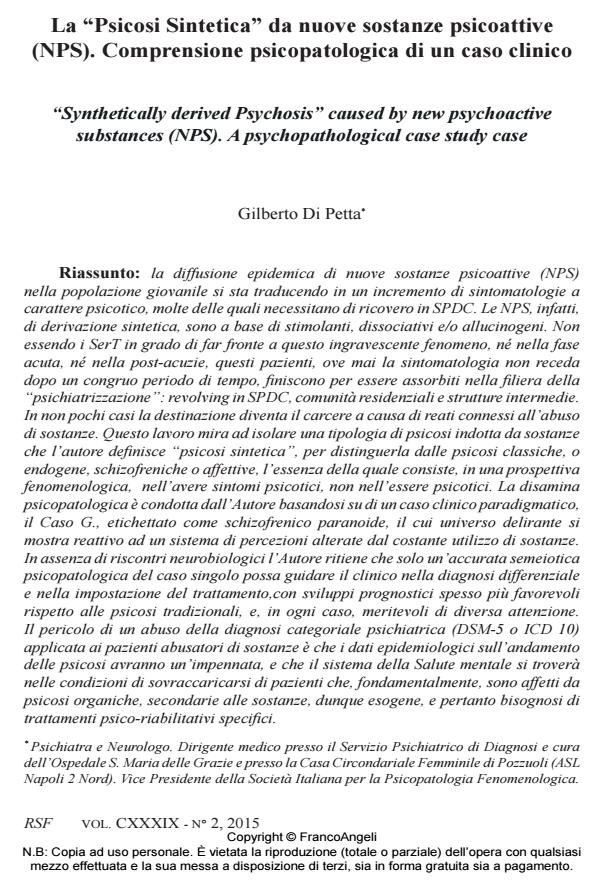"Synthetically derived Psychosis" caused by new psychoactive substances (NPS). A psychopathological case study case
Journal title RIVISTA SPERIMENTALE DI FRENIATRIA
Author/s Gilberto Di Petta
Publishing Year 2015 Issue 2015/2
Language Italian Pages 31 P. 91-121 File size 265 KB
DOI 10.3280/RSF2015-002008
DOI is like a bar code for intellectual property: to have more infomation
click here
Below, you can see the article first page
If you want to buy this article in PDF format, you can do it, following the instructions to buy download credits

FrancoAngeli is member of Publishers International Linking Association, Inc (PILA), a not-for-profit association which run the CrossRef service enabling links to and from online scholarly content.
The epidemic diffusion of new psychoactive substances (NPS) among young people is causing an increase of psychotic symptoms often requiring hospitalisation in a psychiatric secure unit. The NPS are in fact synthetically derived drugs and contain dissociative and/or hallucinogens stimulants. As drug abuse and addiction centres are not able to cope with this growing problem - neither during the acute, nor the post-acute phases - patients with persistent symptoms end up in the psychiatric revolving door phenomenon and are repeatedly admitted to psychiatric secure units and residential treatment facilities. In many other cases, imprisonment is the response to drug-related crime. The author describes substance-induced psychosis, coined "synthetically derived psychosis" to differentiate this type of psychosis from endogenous, schizophrenic or affective psychosis. In a phenomenological perspective the basic trait of substance-induced psychosis consists in suffering psychotic symptoms, but not in being psychotic. The author describes a paradigmatic clinical case in which the patient is labeled paranoid schizophrenic, but whose delusional universe reacts to a system of altered perceptions induced by the constant use of drugs. In the absence of neurobiological evidence the author believes that only a thorough semiotic description of the psychopathology of each individual case can guide the clinician in determining the differential diagnosis and the treatment setting. Substance-induced psychosis has often a better prognosis than the classically defined psychoses, but requires a different clinical approach. .
Keywords: New drugs, exogenous psychosis, substance-induced psychosis, secondary delusion, dermatozoic hallucinations
Gilberto Di Petta, La "Psicosi Sintetica" da nuove sostanze psicoattive (NPS). Comprensione psicopatologica di un caso clinico in "RIVISTA SPERIMENTALE DI FRENIATRIA" 2/2015, pp 91-121, DOI: 10.3280/RSF2015-002008